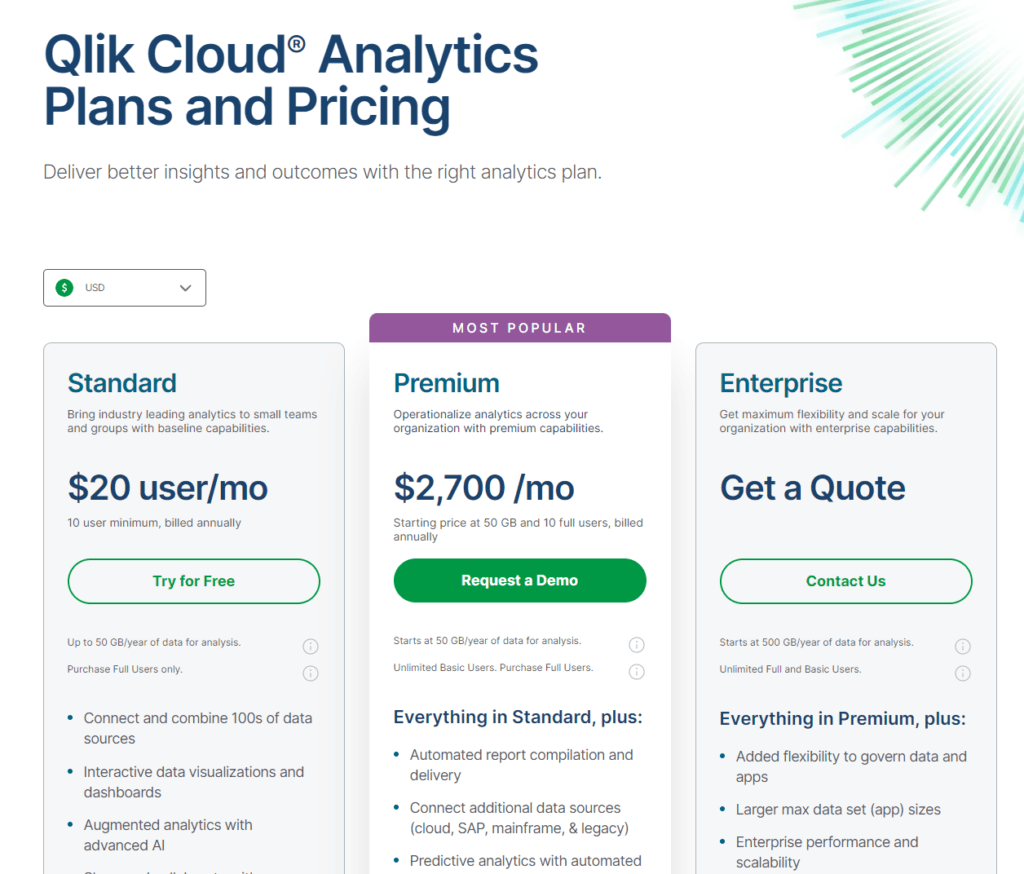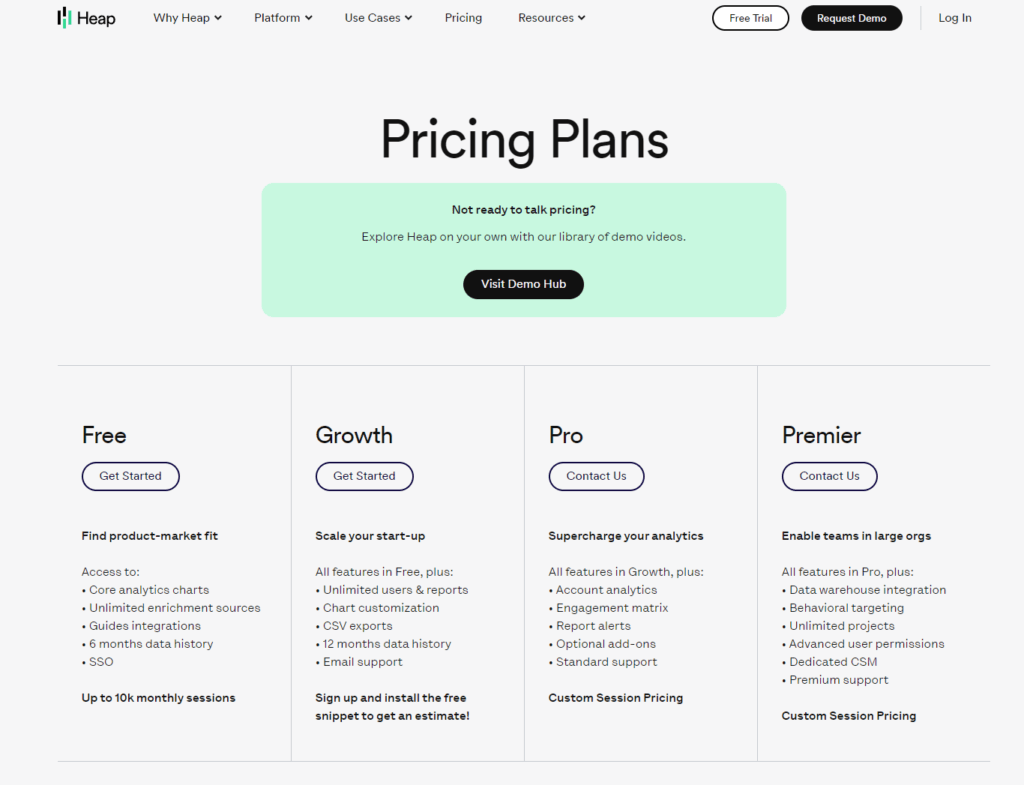In the bustling digital marketplace, the quest for the perfect analytics tool can feel like searching for a beacon in the fog. With an array of options at your disposal, it’s crucial to find a solution that not only illuminates your data but does so in a way that aligns with your business’s unique rhythm. Today, we cast the spotlight on two contenders in this quest: QlikView and Heap. Both tools promise to guide businesses through the murky waters of data towards the shores of insight and action. Yet, they chart their courses using distinct stars. Let’s embark on this journey by diving into their approaches to data integration and automation—an essential consideration in the vast sea of analytics.
| QlikView | Heap |
|---|---|
 |  |
| G2 Score -4.1 out of 5 | G2 Score -4.4 out of 5 |
| TrustRadius Score -8.0 out of 10 | TrustRadius Score -8.2 out of 10 |
Data Integration and Automation: The Winds Behind Your Sails
In the realm of analytics, the ease with which a tool can integrate with your existing data sources and automate the flow of information is akin to catching favorable winds on the open sea. It’s about efficiency, speed, and the seamless melding of various streams of data into a coherent, navigable whole.
QlikView: The Seasoned Navigator
QlikView, with its robust, flexible architecture, is akin to a seasoned navigator, adept at charting courses through complex data landscapes. It offers extensive data integration capabilities, designed to handle a myriad of sources—from legacy systems buried in the depths of a company’s IT infrastructure to the latest cloud-based applications soaring in the digital cloud. QlikView’s ETL (Extract, Transform, Load) functionalities stand out, allowing businesses to meticulously cleanse, transform, and unify data, ensuring that the analytics output is both accurate and actionable.
However, the sophistication of QlikView’s integration and automation features often requires a skilled hand at the helm. Setting up and optimizing these processes can necessitate a deep dive into the tool’s capabilities, sometimes calling for dedicated IT resources or data specialists. For organizations that have such expertise onboard and crave deep, customizable analytics, QlikView offers a powerful set of sails to catch the data winds.
Heap: The Agile Voyager
Heap takes a different tack, positioning itself as the agile voyager of the analytics sea. It focuses on simplicity and speed, especially regarding data integration and automation. Heap automatically captures every user interaction on your website or digital product, from clicks and form submissions to page views, without requiring manual tracking setup. This means that once Heap is integrated—a process designed to be as painless as possible—it begins to chart the user journey in its entirety, without the need for predefined events or tracking codes.
This approach significantly lowers the barrier to entry for businesses without large IT or data teams, allowing them to harness powerful analytics insights quickly. The trade-off, however, is that Heap’s focus on ease of use and automatic data capture might offer less flexibility in data transformation and integration compared to more customizable solutions like QlikView. Yet, for companies prioritizing immediate insights into user behavior with minimal setup, Heap’s sails are designed to catch the wind swiftly.
Pricing: The Map to the Treasure
The pricing model of an analytics tool is the map that leads businesses to uncover the treasure of insights. It’s crucial for this map to be clear, predictable, and aligned with the value it promises to deliver. Here’s a closer look at how QlikView and Heap approach their pricing.
QlikView: Charting Custom Paths

QlikView adopts a tailored approach to pricing, much like charting a custom path through uncharted waters. It operates on a licensing model, which can be customized based on various factors including the number of users, server requirements, and the level of access to different features and support services. This flexibility ensures that businesses only pay for what they need, allowing for a solution that fits their specific requirements.
However, the custom nature of QlikView’s pricing means that understanding the full cost requires a detailed discussion with their sales team to obtain a customized quote. For organizations with complex data needs and a requirement for deep analytics capabilities, QlikView’s model can offer significant value, provided they’re ready to navigate the investment required not just financially but also in mastering its capabilities.
The commitment to QlikView is therefore not just in terms of budget but also involves considering the resources dedicated to leveraging its powerful analytics potential to the fullest.
Heap: Sailing with Transparent Tiers

In contrast, Heap takes a more transparent and straightforward approach with its subscription-based pricing model. It offers clarity from the outset, with costs delineated based on usage levels, particularly the number of sessions tracked. This model provides various tiers, from a free plan suited for smaller sites to enterprise-level offerings designed for businesses with extensive data analysis needs and high volumes of user interactions.
Heap’s transparent pricing model is designed to scale with your business, making it an attractive option for startups and growth-stage companies that require flexibility and predictability in costs. The subscription tiers allow businesses to start small and upgrade as their needs evolve, ensuring that they can continue to leverage Heap’s insights without unexpected jumps in cost.
Depth and Flexibility of Analysis: Navigating Through Data Depths
The ability to dive deep into your data and flexibly adjust your analysis based on evolving business questions is akin to having a versatile, reliable compass on a long sea voyage. Let’s see how our contenders help in charting the depths.
QlikView: The Deep Sea Diver
QlikView is like a seasoned deep-sea diver, equipped for comprehensive explorations into the depths of your business data. It offers a powerful, in-memory data processing engine that allows for the analysis of large datasets with complex relationships. This capability is crucial for businesses that operate across multiple domains and deal with varied data sources.
With QlikView, users can create highly customized reports and dashboards that go beyond surface-level insights. Its associative data model shines here, enabling users to explore data connections intuitively, uncovering hidden patterns and trends that can inform strategic decisions. This level of analytical depth and flexibility is particularly valuable for organizations that have unique, specific questions and require a tool that can adapt to their intricate analytical needs.
However, mastering QlikView’s capabilities to unlock its full potential can require a significant investment in time and expertise. It’s a tool designed for power users—data analysts and professionals who are not daunted by the prospect of a steep learning curve and are keen to leverage advanced data exploration techniques.
Heap: The Agile Navigator
Heap, in contrast, is like an agile navigator, adept at swiftly cutting through the data waves to deliver insights. It excels in providing a user-friendly platform for analyzing user interactions on websites and digital products, automating the data collection process to ensure that no potential insight is lost. This automatic tracking, combined with Heap’s intuitive interface, makes it easy for users to start analyzing data without the need for complex setup or configuration.
While Heap may not offer the same level of customization and depth in data analysis as QlikView, its strength lies in its focus on user behavior analytics. It provides businesses with a clear, immediate understanding of how users engage with their digital platforms, highlighting opportunities for optimization and improvement. For companies that prioritize speed and ease of use in their analytics journey, Heap offers the flexibility to quickly adjust their analysis based on real-time user data.

Related: Check out our free SEO suite

Scalability: Ready for Growth
Scalability in data analytics tools is about more than just handling larger volumes of data; it’s about maintaining performance, accuracy, and usability as your business expands and evolves. Here’s how QlikView and Heap ensure that businesses aren’t left adrift as they grow.
QlikView: The Expanding Vessel
QlikView can be likened to an expanding vessel, designed to grow in capacity and complexity alongside your business. Its powerful in-memory data processing engine and robust architecture make it well-suited to handle increasing volumes of data without sacrificing performance. This capability ensures that businesses can continue to dive deep into their analytics without being hindered by growing pains.
Furthermore, QlikView’s customizable nature means that as your business evolves, your analytics can too. New data sources, changing business models, and evolving market conditions can be integrated into your QlikView setup, allowing it to remain a central pillar of your data strategy.
However, scaling with QlikView often requires foresight and planning. Ensuring that your infrastructure can support growing data demands and that your analytics continue to provide actionable insights as your business scales can necessitate ongoing investment in both hardware and expertise.
Heap: The Agile Schooner
Heap, with its focus on automating data collection and analysis, acts like an agile schooner, swiftly adjusting its sails to the winds of growth. Its cloud-based infrastructure is designed to scale seamlessly, accommodating increases in web traffic and user actions without requiring manual adjustments or expansions from the user’s end.
This scalability is particularly appealing for digital-first businesses that experience rapid growth and need their analytics tools to keep pace without constant tinkering. Heap’s automatic event tracking means that as your product or website evolves, you won’t miss out on capturing valuable user interactions—every click, swipe, and submission is tracked from the start, ensuring your data grows with you.
While Heap scales effortlessly on the technical side, businesses need to consider how their use of analytics might evolve over time. Heap’s focus on user behavior and website interaction provides deep insights in these areas, but companies requiring broader analytics might need to supplement Heap with additional tools or platforms.

I use a relatively lesser known platform called QlikView and QlikSense, however, It has proven to be the most reliable one so far, especially when it comes to providing quality analytics without any bugs or shutdowns.
This platform is essentially a data visualizer with advanced business intelligence tools that offer powerful data analysis. I have been using it for four years now to explore data interactivity, to create dynamic dashboards, and to share insights with my stakeholders during meetings.
All you have to do is to connect the tool to your data sources, for example, if you have an excel spreadsheet, just upload it to the platform; and that’s all! The platform will generate data models for you by loading and transforming all of it using Qlik’s scripting language.
You can use these models to design dashboards and visualize your data. A lot of times, this platform has helped me establish links that I could not have even inferred, which is why I always recommend it to all my colleagues.
When I first started using the platform, I joined a few of its community forums to learn to maximize analytics – this trick really helped me, so don’t forget to do the same.
Jon Molek, Owner/CEO of Best Offer Ohio
Conclusion
Embarking on a data analytics journey with either QlikView or Heap marks the beginning of a deeper understanding of your business and customers. The insights garnered from either platform can illuminate paths to optimization, innovation, and growth. The key lies in leveraging these insights to make informed strategic decisions, fostering a culture of data-driven excellence within your organization.
As we dock at the conclusion of this exploration, remember that the seas of data analytics are vast and ever-changing. Staying informed, adaptable, and open to new technologies and methodologies will ensure that your business not only navigates these waters successfully but also capitalizes on the opportunities they present.
READ NEXT:
- How to Register an NBFC in India: The Definitive Guide
- QlikView vs Mixpanel: The Best Analytics Tool for You
- QlikView vs Statcounter: The Best Analytics Tool for You
- QlikView vs Amplitude: The Best Analytics Tool for You
- “GoSquared vs Mixpanel: The Best Analytics Tool for You”
- 11 Marketing Analytics Tools to Elevate Your Data-Driven Strategies
- 29+ Digital Analytics Software to Skyrocket Your Digital ROI





















Comments are closed.